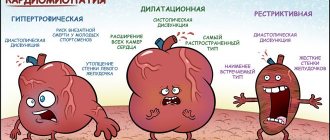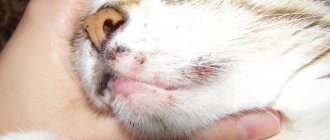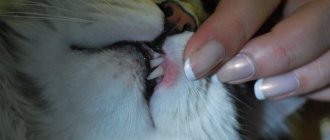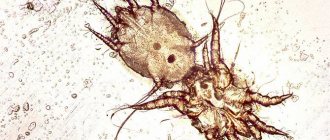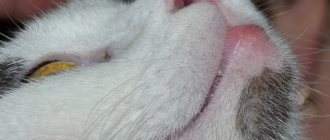Cystitis in cats is one of the same common diseases as urolithiasis. The disorder often recurs, which requires the animal owner to constantly carry out preventive treatment and monitor the pet’s health.
Cystitis in cats
Most often, the inflammatory process in the bladder is recorded in females, which is associated with the characteristics of their body. Treatment of cystitis is carried out by a comprehensive selection of medications by a veterinarian after a preliminary examination and an accurate diagnosis.
Features of the disease in cats
Cystitis is an inflammatory process that develops in the walls of the bladder. The violation can be provoked by several reasons, from banal hypothermia to serious infectious infection. At the initial stage of development, the disease practically does not make itself felt, which is why precious time allotted for treatment is lost. Only an increase in drinking rate and more frequent trips to the toilet can suggest the development of cystitis.
The early stages of the disease usually go undetected
The inflammatory process with such a disorder develops directly inside the bladder on its mucous membrane. The main symptoms of the disease appear when the walls of the organ become tense, when urine begins to put pressure on them. After emptying the bladder, the cat experiences relief for a while. But given the deepening of inflammation in the walls of the organ and the spread of bacteria, the pain becomes constant.
Cystitis affects both the genitourinary system as a whole and the kidneys
If left untreated, cystitis causes serious complications throughout the entire urinary system, gradually rising up and reaching the kidneys. Bacteria can also enter the bloodstream and cause damage to the reproductive system.
Treatment of cystitis in cats is practically no different from treatment of the disorder in humans. The difference is due to the selection of more gentle doses and different durations of the course of suppressing inflammation.
Video - Cystine leakage in a cat
What to do at home if your cat can't pee
The first thing to do if your cat cannot go to the toilet is to take him to the clinic. The doctor will be able to quickly assess the danger of the situation and take radical measures to alleviate the animal’s condition.
First aid
But sometimes circumstances develop in such a way that it is not possible to quickly bring your pet to the hospital. In this case, you should know what to do and how to provide first aid at home to a cat who cannot pee.
To relieve spasm and relax the smooth muscles of the ureters and bladder, male cats should be given an intramuscular injection of No-shpa or Papaverine.
If the cat cannot pee, then as therapy at home you can treat it with Cat Erwin, and also inject it with an antibacterial drug (Tsiprolet, Baytril).
This will help relieve spasm and reduce inflammation for a short period of time. This period should be used to take the cat to the clinic or call a veterinarian at home.
Veterinarian actions
After examining the cat and making a preliminary diagnosis, the veterinarian carries out treatment. It can be roughly divided into 4 stages:
- Preventing stretching and rupture of the bladder in a cat or cat that has not gone to the toilet for more than two days. To do this, a soft catheter with an attached closed system for collecting urine is inserted into the animal. For sterilized cats that periodically cannot pee after castration, a temporary catheter is placed. This is necessary to reduce the risk of developing ascending bacterial infections.
- Stimulation of the bladder muscles. The most effective drug for this is Bethanechol. However, multiple side effects and the need for urgent administration of an antidote in case of intolerance make it possible to use it only in a hospital setting, under the strict supervision of a physician. Cisapride and Propanolol are considered safer drugs for cats. But their independent administration is also prohibited.
- Decreased tone of the urethra and bladder neck. If the obstruction is not associated with anatomical developmental abnormalities, then a cat who has stopped peeing and does not recover for a long time after catheterization is prescribed muscle relaxants (Acepromazine, Diazepam) and alpha-adrenergic antagonists (Phenoxybenzamine, Prazosin).
- Prevention of the development or relief of infectious processes in the lower urinary tract. They often cause systemic inflammation, which can be fatal. Therefore, a veterinarian must prescribe antibacterial drugs to a cat that has not gone to the toilet for the second day or more than 2 days.
Treatment options
At home, it is impossible to diagnose and carry out full effective treatment for a cat that cannot pee in the litter box on its own. This is due to the fact that in addition to conservative methods of therapy, surgical intervention is often used to eliminate this syndrome.
The most common indications for surgery in cats are malignant and benign tissue growths, as well as urolithiasis. A somewhat less common reason for performing surgery on a cat that rarely goes to the toilet is anatomical anomalies in the structure of the organs of the genitourinary system.
Main factors and causes of cystitis development
The following reasons can lead to the formation of a violation:
- improper nutrition of the cat, due to which metabolic processes in the body begin to be disrupted, stones are formed that injure the walls of the bladder and lead to symptoms of cystitis;
- infectious lesions of the urinary system and adjacent organs;
- insufficient fluid in the diet and water with a high content of minerals, which can lead to the formation of stones and salts;
The ability of cats to go without moisture for a long time does not mean that an empty bowl of water can be ignored
- insufficient nutrition or overfeeding of the cat;
- development of urolithiasis and bladder injury;
- stress experienced by the animal;
- hypothermia.
Tense posture when urinating in a cat with cystitis
You cannot think that hypothermia of a cat’s body occurs only in outdoor conditions during the cold or rainy season. Sleeping in a draft, on thin bedding, a bare floor, or swimming in water can ultimately lead to negative consequences and the occurrence of cystitis.
Main types
There are several classifications of cystitis. Depending on the nature of the disease, cystitis can be acute or chronic. The acute form is characterized by a sudden onset and clear clinical signs. The chronic form is characterized by alternating periods of remission (when symptoms are completely absent) and exacerbation.
Depending on the nature of the pathological changes, the following types of cystitis are distinguished:
- Catarrhal. This is the mildest form, which is characterized by only superficial changes. The prognosis in this case is favorable; in almost all cases, complete recovery occurs.
- Hemorrhagic. Characterized by the presence of blood in the urine. This occurs due to increased vascular permeability. In this case, the lesion is deep, and the prognosis is not so favorable.
- Purulent. Most often it is of bacterial etiology (pathogens can be streptococci, staphylococci, E. coli).
Main signs and symptoms of cystitis in cats
You can suspect the presence of a disorder in your pet’s body by the presence of signs typical of bladder inflammation:
- The cat constantly runs to the litter tray to urinate. Often the animal does not manage to get to the toilet, and gradually the pet begins to shit all over the apartment;
- Taking into account the complication of the condition, the animal will feel a constant urge to go to the toilet, but it will not be able to excrete even a small portion of urine;
A cat's unsuccessful trips to the toilet should be a wake-up call for the owner.
- Frequent urges are additionally accompanied by a loud scream, due to a feeling of pain and cutting in the urethra and bladder;
- The excreted urine is dark in color; there may be impurities of blood and stones if the animal additionally suffers from urolithiasis;
- With infections of the urinary system and the development of inflammation, pus may accumulate in the bladder, which gives the urine a rotten smell;
The characteristic unpleasant smell from pet urine indicates internal pathologies.
- Against the background of the inflammatory process, the animal’s body temperature rises, it can reach critical levels in the acute stage;
- The heat provokes fever, the pet refuses to drink and eat;
- The animal is lethargic, does not want to play and constantly lies down;
- When palpating the abdomen, the cat reacts sharply to the touch, as this area becomes painful and a feeling of fullness appears;
- Because of this symptom, the cat cannot lie on its stomach; lying on its side also causes discomfort.
In case of urinary incontinence, the cat is given special diapers.
If a cat experiences swelling in the extremities due to cystitis, we are already talking about the formation of nephrotic syndrome. It is associated with damage to the upper and lower parts of the urinary system.
The need to put a diaper on your cat may shock the owner, but there is nothing complicated or unusual in this procedure. Below are some basic tips for dressing your pet in diapers.
Diapers for cats: application and cost
Video: Symptoms of cystitis in a neutered cat
Symptoms of pathology
The owner will be able to recognize the disease in time and consult a doctor if he has an idea of its symptoms. Timely identified signs will help determine the diagnosis and begin therapy, which is more effective at the initial stage of inflammation. Experts advise paying attention to the following manifestations:
- frequent urination;
- extreme thirst - this is how the body replenishes water loss;
- the pet’s anxiety during urination is caused by pain;
- fever, lethargy, loss of appetite;
- change in the color and smell of the discharge - it becomes cloudy, it may contain pus, mucus or blood, the smell becomes more pungent;
- soreness in the abdominal area - the pet shows anxiety when trying to touch the stomach, does not lie on it, and the groin area is hard.
With cystitis, your pet may be thirsty
It happens that a pet begins to make puddles wherever necessary, often right in front of the owner’s eyes. This is caused by the fact that the pain experienced by the animal during urination causes negative emotions in him when he sees the tray - as a result, the cat begins to avoid it. Experts consider this change in behavior to be one of the characteristic signs of health problems.
Video: signs of cystitis in cats
Diagnosis of disease in animals
To make a diagnosis, several medical procedures are required.
Table 1. Diagnosis of cystitis in cats
| Procedure | Leak details |
| In-person examination by a veterinarian | 1. The doctor collects anamnesis and assesses the external condition of the cat; 2. Palpation of the abdomen and bladder area is mandatory. |
| General blood analysis | 1. The doctor checks how much the leukocyte level has increased; 2. Registers the presence or absence of signs of infection; 3. Monitors ESR |
| General urine analysis | 1. The doctor evaluates the color of the urine and the presence of traces of blood in it; 2. Checks the level of leukocytes and casts; 3. Necessary for culture testing for sensitivity to antibiotics |
| Blood biochemistry | 1. It is carried out with the determination of the hepatic-renal complex; 2. Makes it possible to assess the severity of damage to the urinary system |
| Ultrasound | 1. Assess the degree of neglect of the inflammatory process; 2. Confirms or denies the presence of additional formations in the urinary system |
A cat undergoing an ultrasound
How to avoid relapse (recurrence of the disease)
The most obvious recommendation is no drafts . A cat that has just overcome an infection should under no circumstances be overcooled or exposed to the cold. Also, don't leave it wet for long after swimming.
Still focus on a balanced and nutritious diet . The water consumed by the animal must be filtered and there must be enough of it.
Limit your pet from stress . Create a safe living environment. Any injuries to the back or abdomen can re-cause an already experienced illness.
Don't skip routine checkups with your doctor , even if you don't have symptoms. Take up this habit at least once every six months or once a year.
Vaccines may be prescribed to boost immunity (this is especially true if you have been treated with antibiotics). This will protect the animal from possible subsequent inflammation and infections (the immune system may still be weakened due to taking antibiotics).
(Visited 5,753 times, 1 visits today)
First aid for cystitis in cats
If your pet shows signs of illness, follow these recommendations:
- immediately seek medical help for detailed consultation;
- do not give your pet any painkillers, with the exception of antispasmodics, but you should tell your doctor about their use;
- before contacting a specialist, you need to completely remove food, which will reduce the load on the kidneys and reduce the concentration of urine;
By limiting your pet's food, you will help him by relieving additional stress on his kidneys.
- at the same time, it is strictly forbidden to change the drinking regime; it is even recommended to increase it, which will allow bacteria to be removed from the body faster;
- the cat should be warm and at rest at all times;
- If there are children and other animals at home, the sick pet must be isolated.
Cystitis is dangerous due to rapid dehydration of the body, therefore a sick cat should be provided with good water
You cannot feel the animal’s belly on your own. Cystitis may be accompanied by blockage of the urinary canal, which causes stretching of the bladder walls. Excessive external pressure only increases the tension of the organ and can lead to its rupture.
The cat cannot go to the toilet - alarming symptoms
Untimely outflow of urine can provoke life-threatening conditions for the cat. In stagnant urine, pathogenic bacteria multiply rapidly. The bladder may not be able to withstand the strain. General intoxication of the body is no less dangerous for the health and life of the pet.
Therefore, it is so important to learn how to identify the first symptoms of painful and difficult urination. The following signs of trouble should alert the owner:
- the cat sits in the tray for a long time, spins around, chooses a pose, but in the end the tray is dry;
- the animal screams while trying to urinate;
- cats constantly lick the urethral area and meow pitifully;
- traces of blood, pus, and white flakes are visible in the urine;
- a sudden change in the color or odor of urine;
- urination disorders are accompanied by fever, lethargy, drowsiness, refusal to drink or severe thirst;
- the animal refuses to play, becomes aggressive, restless;
- the abdominal wall becomes painful and tense;
- cats meow and scratch when you try to pick them up.
Effective drugs against cystitis
During treatment, complex medications should be selected to eliminate cystitis. An antibiotic must be prescribed, which has the main antibacterial effect.
Table 2. Medicines against cystitis
| Name | Dosage | A course of treatment | Description |
Stop Cystitis | Tablets: 1 tablet for cats weighing up to five kilograms and 1.5 tablets for cats weighing over five kilograms Suspension: 20 ml for cats up to five kilograms, if the specified weight is exceeded - 30 ml | The number of daily doses and course duration are discussed separately for each individual. | A drug developed specifically for the treatment of cystitis in cats. It is distinguished by its natural composition, which includes nettle, birch, lingonberry and horsetail. Has a complex effect, eliminating inflammation, pain, protecting the pet from the formation of stones |
No-shpa | In the form of injections in a dosage of 0.5 ml morning and evening | No more than one week | An antispasmodic drug that eliminates pain and discomfort when urinating |
Cyston | 0.25-0.5 tablets morning and evening | Up to one month or more, if the condition of the individual requires it | A natural drug that suppresses the signs of cystitis. Well tolerated in combination with antibiotics. The dose depends on the severity of the disorder, the age of the cat, and its condition. literal courses are carried out when inflammation is combined with urolithiasis |
Ceftriaxone | For cats weighing up to two kilograms - 0.5 ml, if this weight is exceeded, the amount of active substance doubles | Up to 10 days (for severe infection) | A powerful antibacterial drug to suppress the growth of bacteria. When treating cystitis in cats, it is used in the form of injections, which are given in the area of the hind paw or thigh. |
Papaverine | 0.5 ml morning and evening | No more than one week | A medication that relaxes smooth muscles, relieving spasms and pain. Also prescribed in the form of injections |
Enrofloxacin | 5 mg/kg daily | no more than 10 days. For moderate and mild infection, the duration of treatment can be 5-7 days | Broad-spectrum antibiotic. Used to relieve pain, inflammation and swelling. Injected subcutaneously |
| Erythromycin | 10-20 mg/kg. The number of daily doses depends on the severity of the disorder. On average - 2 or 3 times a day | Up to two weeks | Broad-spectrum antibiotic. For use in cats only subcutaneously. The lower the weight and age of the cat, the less active substance is administered to it. The number of daily doses depends on the severity of the disorder |
Kotervin | 2-4 ml morning and evening | 7 days. In the future, every 12-16 weeks the product can be used as a prophylaxis | The drug is a sterile solution for oral use. It is distinguished by its most natural composition, which includes knotweed, steelhead root, and horsetail. Once opened, the bottle should not be stored for more than one week. |
All the medications described have analogues. But you cannot replace one drug with another without specifying the new dose and course of treatment. Products with similar effects may have different auxiliary components, which will ultimately lead to allergies.
Unauthorized replacement of some medications with others can lead to a deterioration in the pet’s condition.
Causes of the disease
The cause of the disease can be external and internal factors. The first group includes hypothermia, infection, helminthic infestation, trauma, stress, etc., and the second group includes hormonal imbalance (metabolic disorders, problems with the genitourinary system, the presence of chronic foci of infection in the animal’s body).
Cats are susceptible to inflammation of the bladder mucosa, regardless of age, gender and breed. This is due to the peculiarities of the drinking regime and the high risk of hypothermia and urinary tract injury.
- Hypothermia. Hypothermia is one of the most common causes of cystitis. If your cat walks outside, sleeps in a drafty room, or has a habit of lying under an air conditioner, in a bathtub, on tiles or on a windowsill, she is at increased risk.
- Infectious diseases. The penetration of a bacterial, viral, fungal or other infection is the main cause of cystitis in animals. Hypothermia, decreased immunity and endocrine disorders only create favorable conditions for the proliferation of pathogens. The infection can enter the bladder through ascending, descending and hematological routes (from the urethra, kidneys and other foci of inflammation, respectively).
- Chronic cystitis in cats. Chronic cystitis is often a complication of untreated acute inflammation or other diseases of the urinary tract. Inflammation and damage to the walls of the bladder can occur with kidney failure and urolithiasis. The genitourinary system also suffers from pathologies of the liver, gall bladder and bile ducts.
- Metabolic disease. Disruption of metabolic processes in the body and hormonal imbalance can cause decreased immunity and stagnation of urine. This facilitates the development of infection and prevents the rapid removal of microbes from the urinary tract. An animal's hormonal levels may change after sterilization or castration. After removal of the testicles, cats are at increased risk of developing urolithiasis (UKD), so they need to undergo regular preventive examinations with a veterinarian and undergo a urine test.
In addition to the above factors, the following phenomena can cause the development of cystitis:
- Non-compliance with drinking regime. Many cats do not drink enough fluids, resulting in salt crystals and microbes becoming trapped in the bladder and kidneys. An additional risk factor is the consumption of dry food. The amount of water cats need corresponds to three times the daily food requirement.
- Rare urination. If the litter box is frequently untimely cleaned or the cat does not trust the new place to urinate, urinary retention may occur, which will lead to the growth of bacteria in the favorable environment of urine.
- Stress. The negative impact of stress is due to the fact that excited cats often refuse to eat, drink or go to the toilet, and their immunity decreases due to changes in hormonal levels.
- Back or abdominal injury. A bruise or penetrating wound to the back and abdomen can cause extensive damage to the urinary organs. Severe injuries occur mainly from a direct blow, a fall from a height, or an unsuccessful landing on a protruding object.
- Tumor processes. When neoplasia grows into the wall of the bladder, hemorrhagic cystitis can develop.
Traditional methods of treating disease in cats
Herbal infusions are especially helpful in the presence of bladder inflammation. But they should still be combined with traditional drugs, since cystitis requires a serious antibacterial effect on the site of inflammation.
Table 3. Herbal remedies against cystitis
| Compound | A course of treatment | Recipe | Dosage |
| Plantain, bloodroot and horsetail | 3-7 days | 1. Take plantain, bloodroot and horsetail; 2. In a ratio of 2:1:1, combine and chop the products accordingly; 3. 2-5 grams of herbal ingredients pour 200-250 ml of boiling water; 4. Soak the ingredients for 20 minutes over low heat in a water bath; 5. Remove the broth and cool and bring with clean boiled water to the original volume | 10 ml 30 minutes before meals 4 times a day |
| Oak bark, linden flower part and bearberry | 3-10 days, taking into account the condition of the animal | 1. The ingredients are mixed in equal proportions and crushed; 2. Take a tablespoon of ingredients and pour 250 ml of boiling water; 3. It is necessary to soak the ingredients for 15-30 minutes over low heat, it is better to do this in a water bath; 4. After cooking, the mixture is removed and the plant grounds are completely removed. | Take 5-10 ml half an hour before meals 3 times a day |
| Birch leaves, juniper fruits and dandelion root | No more than 10 days. Minimum course of treatment – 3 days | 1. Combine ingredients in a ratio of 2:1:1; 2. If fresh ingredients are used, they must be washed thoroughly; 3. Having thoroughly crushed the components, pour 250 ml of boiling water into a tablespoon and leave for 8 hours; 4. After infusion, the grounds are removed, the solution should be filtered well | 3-10 ml taking into account the weight and condition of the animal in the morning and evening |
Some decoctions can have a positive effect, but do not forget about possible side effects
The use of natural ingredients does not exclude the occurrence of allergies in a cat. If your pet experiences unwanted reactions such as vomiting, rash, hives, itching, and diarrhea, you should consult a doctor and stop using home methods.
The cat cannot pee: reasons
The most common cause of the disease is urolithiasis. The lumen of the ureter is partially or completely blocked by urolith - a grain of sand or stone formed from precipitated urinary salts.
Statistics show that up to 12% of cats are susceptible to the disease, and predominantly males suffer. This phenomenon is due to the fact that they have a more tortuous and longer urethra than females.
Neutered pets get sick more often than unsterilized pets. This is explained by the fact that after removal of the gonads, the diameter of the ureter ceases to expand in proportion to the increase in live weight. An unbalanced diet, as well as poor water quality, are of great importance in the formation of uroliths. Persians, Siamese, Burmese, and Maine Coons are predisposed to the disease.
In addition to urolithiasis, urinary disorders occur for the following reasons:
- cystitis: inflammation of the bladder, the canal is inflamed, urine is released drop by drop, it hurts to write;
- urethritis - inflammation of the sphincter of the urethra, accompanied by its partial or complete blockage;
- disruption of innervation due to spinal injury;
- polyps on the walls of the bladder or in the urethra obstruct the outflow of urine or cause incontinence;
- kidney diseases.
Features of caring for a cat with cystitis
When eliminating the disease, you must adhere to a number of mandatory tips that will avoid further spread of the disease and deterioration of the cat’s condition:
- Provide your pet with warmth and comfort. He should not sleep on tiles or other cold surfaces;
- Do not use a heating pad or other warming devices. They can increase bleeding and the rate at which bacteria spread;
Any warming of the affected area is fraught with infection.
- Do not combine traditional drugs with folk ones on your own, as such combinations can provoke acute side effects, including anaphylactic shock;
- The diet should be as balanced as possible; it is better to switch exclusively to professional food during the period of therapy;
- If the cat goes outside, it is better to avoid any walks during treatment. The exception is warm days, during which it is allowed to carry your pet in your arms;
During the illness, limit your pet’s contact with the street as much as possible.
- You should not bathe the animal until all symptoms of the pathology have completely disappeared.
It is especially important to monitor the comfort of the pet for those owners who have weakened, lactating and pregnant individuals. In them, the infection spreads several times faster and can reach the kidneys in the first days.
Some individuals suffering from incontinence are recommended to wear special diapers that absorb discharge. Read below to learn about what cat diapers exist and how to make them yourself.
Diaper for a cat
Treatment of a cat with urinary incontinence
Treatment for a cat with urinary incontinence primarily depends on the cause of the problem. If a cat has inflammation, then you cannot do without antibiotics. If the reason lies in excess weight, then you need to take care of a balanced diet and physical activity for the mustache. In the case of a disturbance in the functioning of the nervous system, you need to understand what caused it. This is not always possible to fix. And then you have to put a diaper on the cat. And place several trays in various corners of the apartment.
Preventing urinary incontinence in cats
Prevention of urinary incontinence in a cat is to not allow probable causes to “impact” the whisker. Feed in a balanced manner, avoid drafts in the room, secure the space (so that the pet does not hit or fall from anywhere). Take her to the veterinarian on time, so you will be aware of the health status of your beauty. Unfortunately, it’s more difficult with older animals. No matter how much you take care of your purr, the risk of urinary incontinence in an old cat will not disappear.
More information about urinary incontinence in cats and dogs in the video:
Cat food for bladder inflammation
During the therapy period, it is necessary to minimize the load on the kidneys and the entire body of the animal. When using professional feeds, preference should be given to premium and super-premium products. It is as balanced as possible and designed taking into account the characteristics of the animal.
Advance
It produces a whole line of medications taking into account the age of the pet; there is dry and wet food for weakened and pregnant cats. The composition contains a large number of minerals and vitamins. The feed itself partly consists of meat components and by-products. Cat owners speak positively about the food, noting its quality and affordability. Produced in Spain.
Feed Advance
Bozita
It also produces dry and wet food, produced in Sweden. The product line allows you to choose food for neutered, aged, young and especially large cats. The feed contains no by-products; only pure chicken, beef, rabbit and fish are used. It is not used in the prevention of urolithiasis, as it does not have enough minerals and vitamins; sometimes traces of corn flour can be found.
Bozita food
Eukanuba
It has a separate line of food for cats suffering from kidney and urinary system diseases. Additionally, it is possible to choose dry or wet food, taking into account the age of the pet; it is produced in Holland and Russia. Products of this brand are recommended for sick animals; the components are balanced and easily digestible. They do not cause allergies, so they can be prescribed even to sensitive and allergenic pets.
Eukanuba food line
Royal Canin
The widest range of products for cats of different ages and suffering from various diseases. Properly selected food not only speeds up the elimination of the inflammatory process, but also protects the animal from the appearance of stones and kidney problems in the future. Some owners note the insufficient amount of meat components in canned food and their rather high cost.
Royal Canin for sterilized cats
Happy Cat DE
The German brand has the most enriched composition. It contains no vegetable protein, only meat components and offal. Available in the form of dry food and canned food. There are products for sick cats, kittens, weakened and pregnant individuals. You can also choose food based on your pet’s weight for neutered individuals. The composition contains algae, fruits and medicinal herbs.
Happy Cat DE line of food for domestic cats
Happy Cat IT
Italian brand developed in partnership with veterinarians. It produces dry and wet food taking into account the age of the cat and its health condition. There is a line for sick animals suffering from disorders of the kidneys, liver, and heart. There are foods for obese cats. The composition is enriched with a large number of meat ingredients and vitamins.
Happy Cat IT pate with turkey
Additionally, a cat's diet for cystitis should be enriched with boiled meat; chicken and rabbit are suitable. Boiled bird hearts and gizzards also have a beneficial effect on the body and do not cause intoxication of the body and concentration of urine. If dairy products are well tolerated, cottage cheese and kefir are useful, but they are given once a day in small quantities. Oatmeal and buckwheat porridge are healthy; they can be mixed with boiled meat.
The diet of a cat with cystitis should include various cereals
Diet for difficulty urinating
For an animal that is susceptible to urolithiasis, it is necessary to create a corrective diet. His diet should be rich in glutamic acid and vitamins A, B 6. The following products should be excluded from the feed:
- Pork, since it is a very fatty meat that leads to thickening of urine;
- You should not give milk, as it contains a lot of magnesium, which will further impede the flow of urine;
- It is forbidden to add salt to food;
- Raw meat is also not recommended;
- Fish should be discarded, because the phosphorus contained in it is deposited by the excess mineral in the bladder, leading to the appearance of stones.
In general, it is better to give such an animal a balanced food specially designed for cats with similar problems.
How to treat a pet
Treatment of cystitis in cats at home is possible only after all the necessary diagnostic tests have been carried out and drug therapy has been prescribed.
The course of treatment includes:
- symptomatic therapy (antispasmodics, analgesics);
- antimicrobial drugs and herbal uroseptics;
- medicines for the correction and treatment of the underlying pathology;
- diet and proper drinking regimen.
Before contacting a veterinarian, no medications should be given to a sick pet. If the pain is severe, you can administer a dose of antispasmodic to the cat, calculated according to the weight of the animal. You should inform your doctor about this at your appointment.
Injections for a cat
The preferred form of administration of painkillers and antimicrobial drugs is injections. Parenteral administration ensures the required concentration of active substances in the body, a quick effect and the absence of complications from the gastrointestinal tract.
The following medications are administered to cats in the form of injections:
- antispasmodics (No-shpa, Papaverine);
- analgesics (Baralgin, Analgin, Revalgin);
- antibiotics (Gentamicin, Amoxiclav, Levomycetin);
- immunostimulants (IBS).
Antimicrobial agents should be given in a course, without stopping therapy at the first signs of relief in the cat’s condition.
The following medications may be prescribed for oral administration:
- Salol;
- CatErwin;
- Stop cystitis;
- Canephron;
- Cyston;
- Cantaren;
- probiotics (Lactovit, Bifitrilak).
Traditional methods of treatment
Treating a cat without the advice of a veterinarian is very dangerous, because... this can lead to chronicity of the disease and the development of complications in the kidneys.
Step-by-step treatment plan.
With the permission of the doctor, symptomatic therapy can be supplemented with infusions and decoctions of the following plants:
- plantain, bearberry, birch, lingonberry, nettle (leaves);
- cinquefoil;
- horsetail;
- chamomile (flowers), etc.
CatErwin or Stop-cystitis: which is better?
KotErwin are anti-inflammatory and mild diuretic drops that contain extracts of knotweed (field and kidney), horsetail and steelhead root. This drug is best suited for the prevention of urolithiasis and urological syndrome.
Stop-cystitis contains both herbal components (extracts of juniper, lingonberry and birch leaves, nettle, knotweed and licorice root) and medicinal preparations (antibiotic nitroxoline and antispasmodic drotaverine). It comes in tablet form and is suitable for the treatment of bladder inflammation.
Stop Cystitis Bio contains only herbal ingredients and is suitable for the prevention of cystitis in cats.
